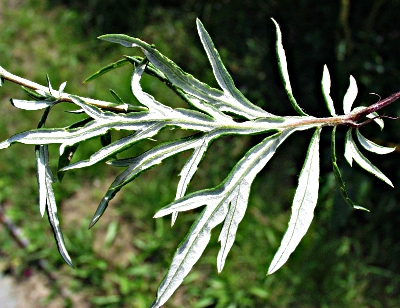Mugwort |




Inflorescence,
flower heads, upper and lower surface of leaves
from the
mugwort
| Artemisia vulgaris L.: | |
| Blooming period: | July–Oktober |
| Height: | 60 to no more than 190 cm |
| Flowers: | in heads, Ø of the heads approx. 3 mm, stamens: 5, styles: 1 |
| Ray florets: | female, 7–10, yellow |
| Disc florets: | hermaphrodite, 8–20, yellow |
| Calyx: | missing |
| Leaves: | alternate, pinnatipartite |
Plant perennial, herbaceous, woody with time from the bottom up.
Rhizome horizontally, rough, Ø up to 20 mm.
Stem erect, striped red-brown or only slightly grooved, strongly branched.
Lower leaves short-stalked, broadly ovate, pinnatipartite. Middle stem leaves sessile or stalked very short, deeply incised. Upper stem leaves in the area of the inflorescence sessile, linear-lanceolate, entire, pointed.
Leaves on upper surface glabrous or sparsely hairy, green, underneath with white hairs.
The small, yellow or brownish flower heads are clustered in raceme-like to panicle-like inflorescences.
Flower heads at the margin with 7–10 female, 1.75–2 mm long florets. Tube 2-dentate. In the interior 8–20 hermaphrodite, 1.5-2 mm long, 5-dentate disc florets. Florets at the base without chaffy scales. Receptacle hemispherical.
Involucre 3–4 mm long. Phyllaries in 4 rows, 1–1.5 mm long, felty-white outside, with membranous margins, pointed.
Pollination by wind. The inferior ovary forms a up to 1 mm long straight, brown, slightly grooved nut fruit (achene) without a Pappus. Plant with an aromatic scent, especially when rubbed, slightly toxic!
| Floral formula: |
| * K0 C(5) G(2) inferior
and * K0 [C(5) A5(connate)] G(2) inferior |
Occurrence:
Paths
and forest margins, embankments. Prefers slightly warm, moist and very
nitrogen-rich locations.
Distribution:
The
whole of Europe, Asia and North Africa. Introduced in North America.